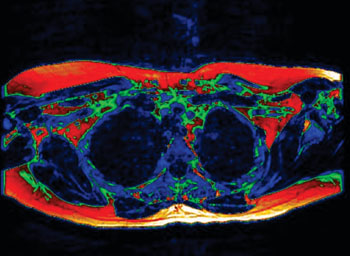Brown Fat Research Advances with a Ground-Breaking MRI Scan
By MedImaging International staff writers
Posted on 05 May 2014
A magnetic resonance imaging (MRI) scan is the first to show “brown fat” in a living adult, and could provide vital information for new treatments to aid the fight against diabetes and obesity.Posted on 05 May 2014
Researchers from Warwick University Medical School (Coventry, UK) and University Hospitals Coventry (UK) and Warwickshire NHS [National Health Service] Trust used MRI-based technology to identify and validate the presence of brown adipose tissue in a living adult.

Image: The first MRI scan to show “brown fat” in a living adult could prove to be an essential step towards a new wave of therapies to aid the fight against diabetes and obesity (Photo courtesy of Warwick Medical School).
Brown fat has become a heated subject for scientists because its ability to use energy and burn calories, helping to keep weight in check. Understanding the brown fat tissue and how it can be utilized is of growing interest in the search to help obese individuals or at a high risk of developing diabetes.
Dr. Thomas Barber, from the department of metabolic and vascular health at Warwick Medical School, explained, “This is an exciting area of study that requires further research and discovery. The potential is there for us to develop safe and effective ways of activating this brown fat to promote weight loss and increase energy expenditure--but we need more data to be able to get to that point. This particular proof of concept is key, as it allows us to pursue MRI techniques in future assessments and gather this required information.”
The study published January 2014 in the Journal of Clinical Endocrinology and Metabolism described the advantages of using MRI scans over the existing method of positron emission tomography (PET). While PET imaging reveals brown fat activity, it is subject to a range of limitations including the challenge of signal variability from a changing environmental temperature.
In contrast to the PET data, which only displays activity, MRI can show brown fat content whether active or not, providing a detailed insight into where it can be found in the adult body. These data could become vital in the development of future therapies that seek to activate deposits of brown fat.
Dr. Barber added, “The MRI allows us to distinguish between the brown fat, and the more well-known white fat that people associate with weight gain, due to the different water to fat ratio of the two tissue types. We can use the scans to highlight what we term ‘regions of interest’ that can help us to build a picture of where the brown fat is located.”
With the proof of concept study now completed, the next phase of research is to further corroborate this technique across a larger group of adults.
Related Links:
Warwick University Medical School
University Hospitals Coventry














